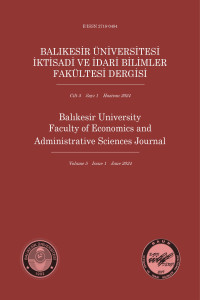Öz
Monitoring, identifying and recognizing the behaviors of tourists provides the advantage of the tourism product seeing from the perspective of the tourist market. The main objective of this study is to measure of the tourist viewpoints of open-minded viewers and the predetermined levels of short time by the observation method which is one of the biometric measurement techniques. The eye tracing technique was applied in the study. In the 2018-2019 academic year, 40 volunteer students from various departments of the tourism in the Meselik Campus of Eskisehir Osmangazi University participated in the study. Independent t test and ANOVA test are used for analysis. There was a significant difference in the level of attention of the future against destinations with “UNESCO” and “CITTASLOW ” stimuli. The visualization of destinations with a destination CITTASLOW a stimulus was made to have higher recall rates for the indications of non-stimulated destinations. In addition, the logo and text sections of the destinations that have the “UNESCO ”stimulus reach to the unstimulated destinations have a higher recall rate.
Anahtar Kelimeler
Kaynakça
- Lindstrom, M. (2016). buy.ology, Çeviri: Ümit Şensoy, İstanbul.
- Morin, C. (2011). Neuromarketing: The New Science of Consumer Behavior. Society, 48(2).
- Pieters, R., Edward, R. ve Wedel, M. (1999). Visual Attention To Repeated Print Advertising: A Test Of Scanpath Theory. Journal Of Marketing Research, 36(4).
- Pieters, R. ve Wedel, M. (2004). Attention Capture And Transfer In Advertising: Brand, Pictorial and text size effects. Journal Of Marketing, 68(2).
- Popa, L., Selejan, O. ve Scott, A. (2015). Reading Beyond The Glance: Eye Tracking In Neurosciences. Neurological Sciences, 36(5).
- Seric, N., Jurisic, M. ve Petricevic, D. (2015). Neuromarketing Potential for Tourist Destinastion Brand Positioning. Tourism in Southern and Eastern Europe, 3, 2015.
- Stipp, H. (2015). “The Evolution of Neuromarketing Research: From Novelty to Mainstream”, Journal of Advertising Research.
- Tsvetanova, E (2018). Destinastion Marketing Activities for Sustainable Urban Development (Following The Example of the Town of Pleven). Journal of Thermal Engineering, 4(4).
- Ustaahmetoğlu, E. (2015). Nöropazarlama Üzerine Bir Değerlendirme. Business & Management Studies: An International Journal, 3(2).
- Yaman, C., Tomris Küçün, N., Güngör, S., Eroğlu, S. (2018). Reklamlara Yönelik Dikkatin Göz İzleme Tekniği İle Ölçülmesi Ve Bağlam Etkisi. Journal of Life Economics, 5(4), 221-232. https://doi.org/10.15637/jlecon.271
- Yücel, A. ve Coşkun, P. (2018). Nöropazarlama Literatür İncelemesi. Fırat Üniversitesi Sosyal Bilimler Dergisi, 28(2).
- Wedel, M. (2013). Attention Research In Marketing: A Review Of Eye Tracking Studies.
- Wedel, M. ve Rik, P. (2000). Eye Fixations On Advertisements And Memory For Brands: A Model And Findings. Marketing Science, 19(4).
Öz
Turistlerin davranışlarını izlemek, anlamak ve tanımak turizm ürününü turist perspektifinden görmek ve bu açıdan geliştirmek pazar içinde avantaj kazandırmaktadır. Bu çalışmanın temel amacı UNESCO eseri barındıran ve Cittaslow unvanına sahip olan destinasyonların turist bakış açısıyla dikkat çekiciliklerinin ve kısa süreli hatırlanma düzeylerinin biyometrik ölçümleme tekniklerinden olan göz izleme yöntemi ile ölçülmesidir. Çalışmada göz izleme tekniği uygulanmıştır. Çalışmaya 2018-2019 öğretim yılında Eskişehir Osmangazi Üniversitesi Meşelik Yerleşkesi’ nde bulunan fakültelerin turizm bölümü hariç çeşitli bölümlerinde okuyan 40 gönüllü öğrenci katılmıştır. Analizlerde bağımsız t testi ve ANOVA testi kullanılmıştır. Analizler sonucunda “UNESCO” ve “CITTASLOW” uyaranına sahip destinasyonlara karşı katılımcıların dikkat düzeylerinde anlamlı bir farklılık olmadığı saptanmıştır. Kısa süreli hatırlama oranları incelendiğinde “CITTASLOW” uyaranına sahip olan destinasyonların görsellerinin uyaransız destinasyonların görsellerine kıyasla hatırlama oranlarının daha yüksek olduğu tespit edilmiştir. Ayrıca “UNESCO” uyaranına sahip destinasyonların logo ve metin bölümlerinin uyaransız destinasyonlara kıyasla daha yüksek hatırlama oranına sahip olduğu gözlemlenmiştir.
Anahtar Kelimeler
destinasyon pazarlaması nörpazarlama eye- tracking unesco cittaslow
Kaynakça
- Lindstrom, M. (2016). buy.ology, Çeviri: Ümit Şensoy, İstanbul.
- Morin, C. (2011). Neuromarketing: The New Science of Consumer Behavior. Society, 48(2).
- Pieters, R., Edward, R. ve Wedel, M. (1999). Visual Attention To Repeated Print Advertising: A Test Of Scanpath Theory. Journal Of Marketing Research, 36(4).
- Pieters, R. ve Wedel, M. (2004). Attention Capture And Transfer In Advertising: Brand, Pictorial and text size effects. Journal Of Marketing, 68(2).
- Popa, L., Selejan, O. ve Scott, A. (2015). Reading Beyond The Glance: Eye Tracking In Neurosciences. Neurological Sciences, 36(5).
- Seric, N., Jurisic, M. ve Petricevic, D. (2015). Neuromarketing Potential for Tourist Destinastion Brand Positioning. Tourism in Southern and Eastern Europe, 3, 2015.
- Stipp, H. (2015). “The Evolution of Neuromarketing Research: From Novelty to Mainstream”, Journal of Advertising Research.
- Tsvetanova, E (2018). Destinastion Marketing Activities for Sustainable Urban Development (Following The Example of the Town of Pleven). Journal of Thermal Engineering, 4(4).
- Ustaahmetoğlu, E. (2015). Nöropazarlama Üzerine Bir Değerlendirme. Business & Management Studies: An International Journal, 3(2).
- Yaman, C., Tomris Küçün, N., Güngör, S., Eroğlu, S. (2018). Reklamlara Yönelik Dikkatin Göz İzleme Tekniği İle Ölçülmesi Ve Bağlam Etkisi. Journal of Life Economics, 5(4), 221-232. https://doi.org/10.15637/jlecon.271
- Yücel, A. ve Coşkun, P. (2018). Nöropazarlama Literatür İncelemesi. Fırat Üniversitesi Sosyal Bilimler Dergisi, 28(2).
- Wedel, M. (2013). Attention Research In Marketing: A Review Of Eye Tracking Studies.
- Wedel, M. ve Rik, P. (2000). Eye Fixations On Advertisements And Memory For Brands: A Model And Findings. Marketing Science, 19(4).
Ayrıntılar
| Birincil Dil | Türkçe |
|---|---|
| Konular | Hizmet Pazarlaması, Sosyal Pazarlama, Pazarlama (Diğer) |
| Bölüm | Araştırma Makaleleri |
| Yazarlar | |
| Yayımlanma Tarihi | 27 Haziran 2024 |
| Gönderilme Tarihi | 21 Mayıs 2024 |
| Kabul Tarihi | 27 Haziran 2024 |
| Yayımlandığı Sayı | Yıl 2024 Cilt: 5 Sayı: 1 |

This work is licensed under a Creative Commons Attribution-NonCommercial 4.0 International License.


